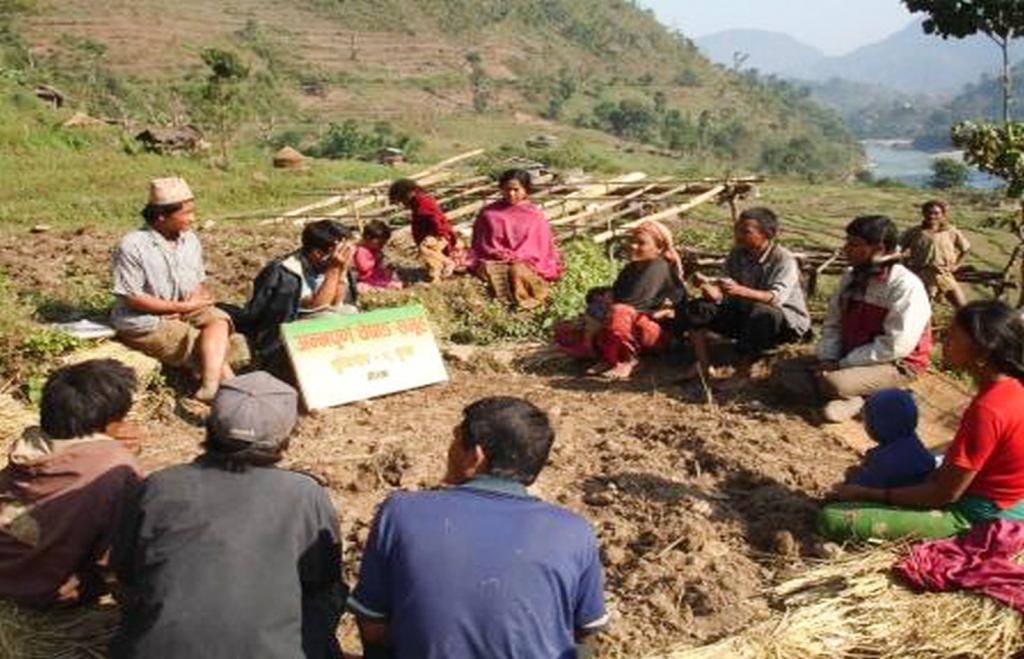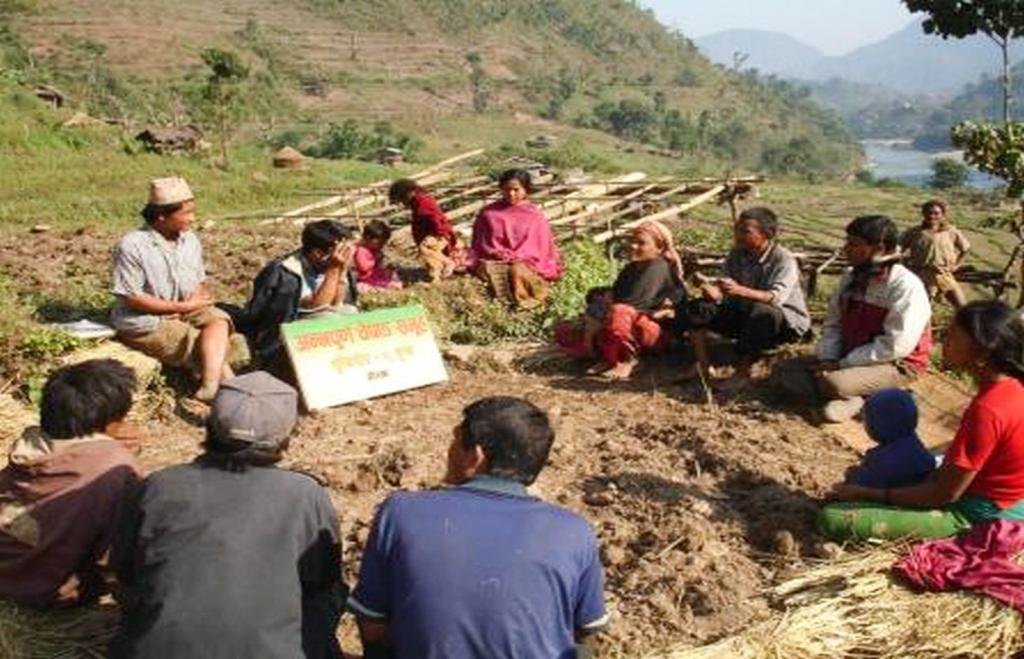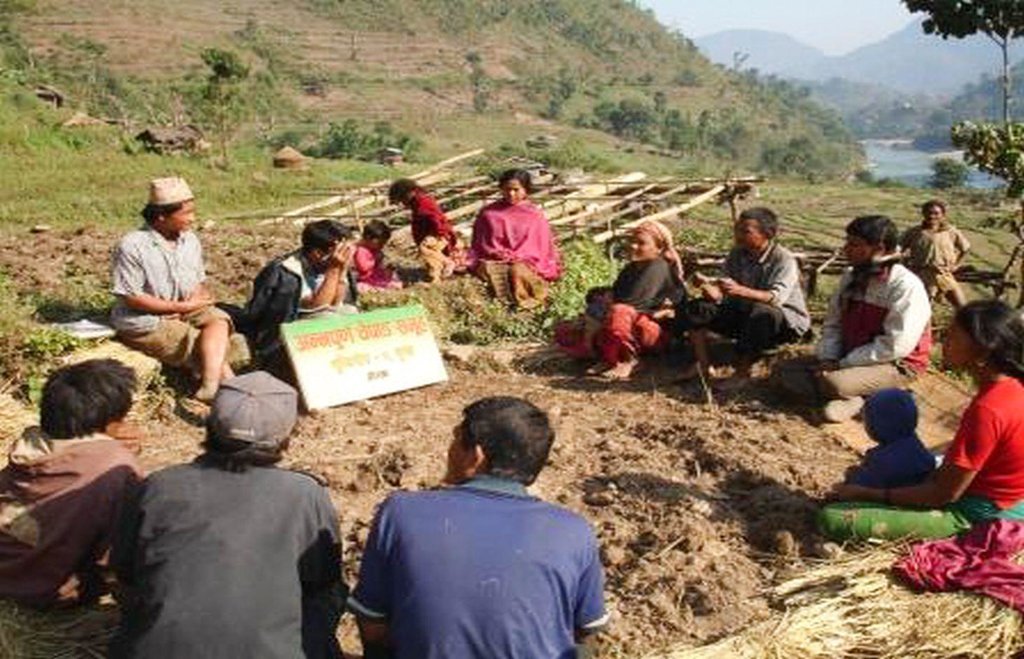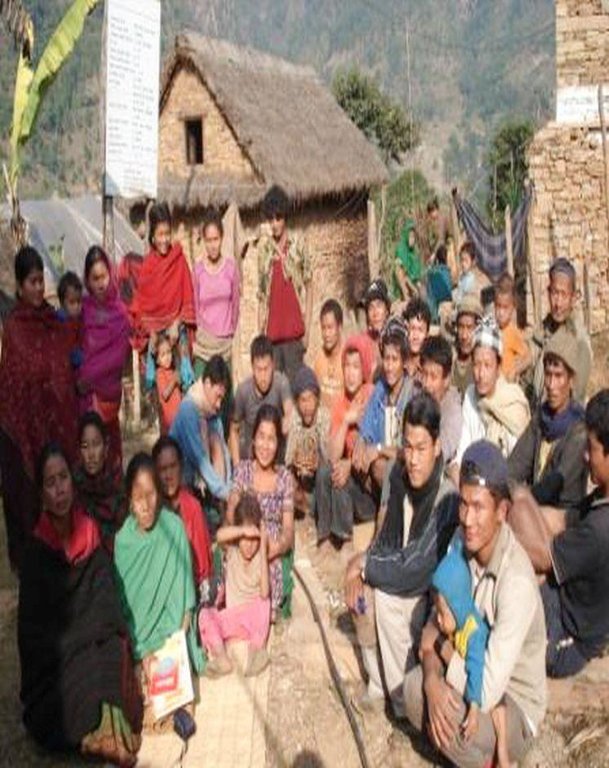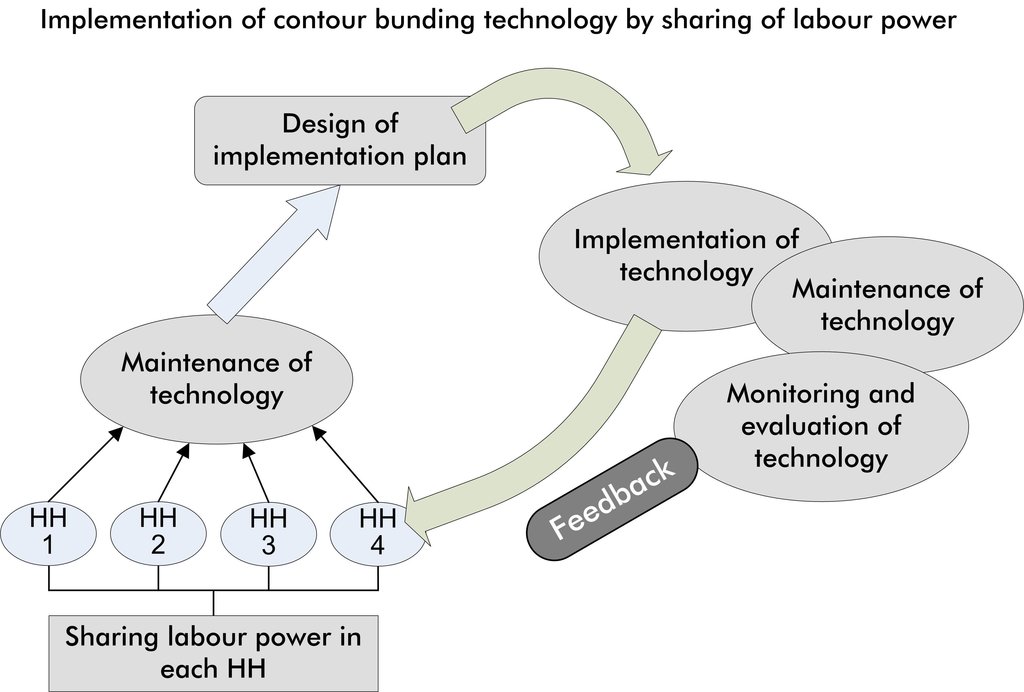Sharing labour to implement contour bunding [Népal]
- Création :
- Mise à jour :
- Compilateur : Shreedip Sigdel
- Rédacteur : –
- Examinateur : Fabian Ottiger
Janasakti aadanpradhan gari bhajo halne padhiti karanwanan (Main contributor: Bir Bahadur Tamang, LI-BIRD)
approaches_2604 - Népal
Voir les sections
Développer tout Réduire tout1. Informations générales
1.2 Coordonnées des personnes-ressources et des institutions impliquées dans l'évaluation et la documentation de l'Approche
Spécialiste GDT:
Tamanag Bir Bahadur
+977 61 526834 (0); 9746005992 (M)
btamang@libird.org
LI-BIRD, Gairapatan, Pokhara, P.O. Box 324
Népal
Nom du ou des institutions qui ont facilité la documentation/ l'évaluation de l'Approche (si pertinent)
ICIMOD International Centre for Integrated Mountain Development (ICIMOD) - NépalNom du ou des institutions qui ont facilité la documentation/ l'évaluation de l'Approche (si pertinent)
Local Initiatives for Biodiversity, Research, and Development (LI-BIRD) - Népal1.3 Conditions relatives à l'utilisation par WOCAT des données documentées
Quand les données ont-elles été compilées (sur le terrain)?
01/03/2013
Le compilateur et la(les) personne(s) ressource(s) acceptent les conditions relatives à l'utilisation par WOCAT des données documentées:
Oui
2. Description de l'Approche de GDT
2.1 Courte description de l'Approche
Members of a community can work together to help prevent soil erosion and increase productivity by working collectively to establish contour bunds.
2.2 Description détaillée de l'Approche
Description détaillée de l'Approche:
Aims / objectives: Over generations, the ethnic minorities of Nepal, who practice fireless shifting cultivation, known as 'gujultyaune', have successfully used contour bunding to control soil erosion, promote water retention, and increase crop production. Contour bunding is a proven sustainable land management practice in areas where the soil productivity of marginal, sloping, and hilly lands is very low. While it is both low cost and simple to implement, it does have the drawback that establishing contour bunds is very labour intensive. When members of a community work together to establish contour bunds the whole village can benefit.
Methods: By working collectively, a community can establish contour bunds that will benefit everyone and not individual farmers alone. The first step is to plan a course of action and to select the sites. Members of the community, who are thoroughly familiar with the landscape that the community inhabits, get together to discuss where the contour bunding will be most successful and benefit the greatest number of farmers. This planning phase is best carried out during the dry season before the rains begin. Once the sites are selected, everyone participates in the slashing of materials on the shifting cultivation lands. After the slashed materials have been allowed to dry for some weeks, the community assembles to gather these into rows that will form the bunds. Every member of the community participates according to their ability.
Stages of implementation: The steps for sharing labour to establish contour bunds in a community which practises shifting cultivation can be summarized as follows:
• The community meets to finalize a plan of action.
• Everyone participates in the slashing of shifting cultivation plots.
• The slashed materials are collected and allowed to dry.
• The slashed materials are formed into rows that will constitute the bunds.
• Everyone participates and eventually, the land between the bunds is prepared for the cultivation of crops.
2.3 Photos de l'approche
2.5 Pays/ région/ lieux où l'Approche a été appliquée
Pays:
Népal
Autres spécifications du lieu :
Tanahun, Gorkha District
2.7 Type d'Approche
- traditionnel/ autochtone
2.8 Principaux objectifs de l'Approche
The Approach focused mainly on SLM with other activities (increasing crop production)
To increase crop yields and help to prevent soil erosion in communities that practise shifting cultivation by getting the whole community to participate in establishing contour bunds.
The SLM Approach addressed the following problems: The main stumbling blocks to this approach are a gap in the sharing of traditional knowledge, lack of the money needed for investment, community conflicts over allocation of resources, and overall poor social cohesiveness.
2.9 Conditions favorisant ou entravant la mise en œuvre de la(des) Technologie(s) appliquée(s) sous l'Approche
disponibilité/ accès aux ressources et services financiers
- entrave
Individual farmers do not have sufficient resources to
implement the technology on their own
Treatment through the SLM Approach: By sharing labour everyone benefits without any outlay by individual farmers
cadre institutionnel
- entrave
Groups are not aware of how to mobilize for community empowerment
Treatment through the SLM Approach: Raise level of awareness and enhance capacity on how to mobilize the community and on how to institutionalize the process
connaissances sur la GDT, accès aux supports techniques
- entrave
Traditional knowledge on contour bunding is not shared
Treatment through the SLM Approach: Technical information is shared when the technology is implemented
3. Participation et rôles des parties prenantes impliquées dans l'Approche
3.1 Parties prenantes impliquées dans l'Approche et rôles
- exploitants locaux des terres / communautés locales
This technology is straightforward; the community of land users can implement it without external input. This is a sustainable land management practice in areas where shifting cultivation is practised. These areas have typically been inhabited by poor and marginal groups like the Chepang, Magar, Dalit, and Gurung groups.
3.2 Participation des exploitants locaux des terres/ communautés locales aux différentes phases de l'Approche
| Participation des exploitants locaux des terres/ communautés locales | Spécifiez qui était impliqué et décrivez les activités | |
|---|---|---|
| initiation/ motivation | auto-mobilisation | Demand created by the community |
| planification | interactive | Through discussions the whole community is involved in deciding what sites are to be contoured and how the bunding technology is to be implemented. |
| mise en œuvre | auto-mobilisation | The whole community is involved in planning the sites, slashing the biomass, and forming the contour bunds. |
| suivi/ évaluation | aucun | |
| Research | aucun |
3.3 Diagramme/ organigramme (si disponible)
Description:
Each household (HH) contributes labour and the community works together to implement contour bunding.
Auteur:
AK Thaku
3.4 Prises de décision pour la sélection de la Technologie/ des Technologies
Indiquez qui a décidé de la sélection de la Technologie/ des Technologies à mettre en œuvre:
- les exploitants des terres seuls (auto-initiative)
Expliquez:
The land users themselves decide on the technology during participatory discussions held in the community. This is a bottom-up approach
Decisions on the method of implementing the SLM Technology were made by by land users* alone (self-initiative / bottom-up). The land users themselves possess traditional knowledge on how the technology should be implemented. Since some farmers have a better grasp of the technology than others, the different methods are discussed and the community as a whole decides what method is to be used.
4. Soutien technique, renforcement des capacités et gestion des connaissances
4.1 Renforcement des capacités/ formation
Une formation a-t-elle été dispensée aux exploitants des terres/ autres parties prenantes?
Oui
Spécifiez qui a été formé:
- exploitants des terres
Formats de la formation:
- entre agriculteurs (d'exploitants à exploitants)
- zones de démonstration
- réunions publiques
4.2 Service de conseils
Les exploitants des terres ont-ils accès à un service de conseils?
Oui
4.3 Renforcement des institutions (développement organisationnel)
Des institutions ont elles été mises en place ou renforcées par le biais de l'Approche?
- non
4.4 Suivi et évaluation
Le suivi et l'évaluation font ils partie de l'Approche? :
Oui
Commentaires:
bio-physical aspects were regular monitored by land users through measurements; indicators: Land users regularly monitor the organic matter and moisture content of the soil and establish plants in bunds
technical aspects were regular monitored by land users through measurements; indicators: Land users regularly monitor terrace formation and soil erosion
socio-cultural aspects were regular monitored by land users through observations; indicators: The community observes and comments on the degree to which contour bunding is implemented
economic / production aspects were regular monitored by land users through measurements; indicators: Land users note crop production and how it affects their cash income
area treated aspects were regular monitored by land users through measurements; indicators: Land users regularly monitor small patches used in shifting cultivation
no. of land users involved aspects were regular monitored by land users through observations; indicators: The whole community participates in observing how many people are involved
management of Approach aspects were regular monitored by land users through measurements; indicators: The whole community participates
There were few changes in the Approach as a result of monitoring and evaluation: Gradually, farmers in other communities are also adopting the same approach
5. Financement et soutien matériel externe
5.1 Budget annuel de la composante GDT de l'Approche
Si le budget annuel précis n'est pas connu, indiquez une fourchette:
- < 2 000
Commentez (par ex. principales sources de financement/ principaux bailleurs de fonds):
Approach costs were met by the following donors: national non-government (LI-BIRD): 20.0%; local community / land user(s): 80.0%
5.2 Soutiens financiers/ matériels fournis aux exploitants des terres
Les exploitants des terres ont-ils reçu un soutien financier/ matériel pour la mise en œuvre de la Technologie/ des Technologies?
Non
5.4 Crédits
Des crédits ont-ils été alloués à travers l'Approche pour les activités de GDT?
Non
6. Analyses d'impact et conclusions
6.1 Impacts de l'Approche
Est-ce que l'Approche a aidé les exploitants des terres à mettre en œuvre et entretenir les Technologies de GDT?
- Non
- Oui, un peu
- Oui, modérément
- Oui, beaucoup
The approach was a good way of improving sloping land management.
Est-ce que l'Approche a autonomisé les groupes socialement et économiquement défavorisés?
- Non
- Oui, un peu
- Oui, modérément
- Oui, beaucoup
Moderate improvements were noted in Chepang, Magar, and Dalit households who benefited from this approach and improved their livelihoods
Did other land users / projects adopt the Approach?
- Non
- Oui, un peu
- Oui, modérément
- Oui, beaucoup
Those who implemented this approach cited improved soil fertility and the increased productivity of cash crops like legumes as a plus point.
Did the Approach lead to improved livelihoods / human well-being?
- Non
- Oui, un peu
- Oui, modérément
- Oui, beaucoup
these were mainly due to the increased earnings from the production of cash crops. Earnings were invested on daily needs which improved livelihoods.
Did the Approach help to alleviate poverty?
- Non
- Oui, un peu
- Oui, modérément
- Oui, beaucoup
Some poverty alleviation was noted among households who could increase the amount that they earned from cash crops. These households used the additional earnings on health care and education.
6.2 Principale motivation des exploitants des terres pour mettre en œuvre la GDT
6.3 Durabilité des activités de l'Approche
Les exploitants des terres peuvent-ils poursuivre ce qui a été mis en œuvre par le biais de l'Approche (sans soutien extérieur)?
- oui
Si oui, décrivez de quelle manière:
This is a community-based approach; each community formulates its own rules and regulations.
6.4 Points forts/ avantages de l'Approche
| Points forts/ avantages/ possibilités du point de vue du compilateur ou d'une autre personne ressource clé |
|---|
| Effectiveness (How to sustain/ enhance this strength: Improve the approach by continuing to work together to design, plan, and implement.) |
| Increases social cohesiveness (How to sustain/ enhance this strength: Continue to work collaboratively) |
| Decreased workload (How to sustain/ enhance this strength: Over time, the group decisions that work best no longer need to be revisited and less time is spent in discussions.) |
| Quick implementation of sloping land management measures (How to sustain/ enhance this strength: As the group learns to work together they can taking advantage of their synergy to quickly implement new measures.) |
| Empowerment (How to sustain/ enhance this strength: Encourage the community with technical backstopping) |
6.5 Faiblesses/ inconvénients de l'Approche et moyens de les surmonter
| Faiblesses/ inconvénients/ risques du point de vue du compilateur ou d'une autre personne ressource clé | Comment peuvent-ils être surmontés? |
|---|---|
| Some members contribute more than others | Each member of the group needs to be made aware of how they can contribute. |
7. Références et liens
7.1 Méthodes/ sources d'information
- visites de terrain, enquêtes sur le terrain
- interviews/entretiens avec les exploitants des terres
7.2 Références des publications disponibles
Titre, auteur, année, ISBN:
Indigenous knowledge of farmers in the shifting cultivation areas of Western Nepal, Regmi, BR; Aryal, KP; Subedi, A; Shrestha, PK; Tamang, BB (2001)
Liens et modules
Développer tout Réduire toutLiens
Aucun lien
Modules
Aucun module trouvé


